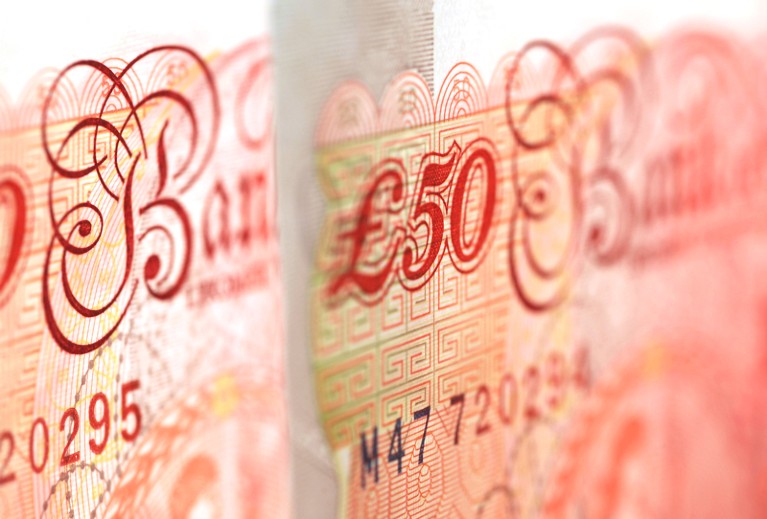
The Bank of England should choose a woman scientist for its new £50 note.Credit: Christopher Cox/Bloomberg/Getty
What does Marie Curie have in common with the bacteriologist Hideyo Noguchi and the theoretical astrophysicist Victor Ambartsumian? They are among the scientists who have featured on banknotes around the world (respectively, the old 20,000 Polish zloty, the ¥1,000 in Japan and the 100 Armenian dram). Now, the British public has the chance to choose who should join them. Last week, the Bank of England announced that it is looking for an inspirational scientist to appear on the next £50 note. It has invited suggestions and will pass them to a dedicated committee, which will make the final decision and announce it next year.
Scientists and engineers have featured heavily on UK banknotes since the bank started to print historical figures on their reverse sides in 1970. Generations of Britons have been paid with notes depicting Isaac Newton, George Stephenson, Michael Faraday and Florence Nightingale. The designs have not always pleased everyone. The £10 note released in 2000 featured Charles Darwin and his trip on HMS Beagle, but also threw in some hummingbirds — which many biologists felt were irrelevant.
Whoever is chosen (the only binding criteria are that they must be British and dead) will replace the steam-engine pioneers Matthew Boulton and James Watt on the £50 note, the highest denomination in circulation. It has yet to feature a woman, and this has led to suggestions that the Bank of England should choose a female scientist. Nature agrees. It’s true that this would rule out deserving figures such as Alan Turing and Stephen Hawking (who died this year and who bank officials have said would be allowed, even though the bank usually expects banknote candidates to have been dead for at least 20 years). But here is an opportunity to celebrate the hugely important achievements of a woman in science, and to offer an important and inspiring role model at the same time.
A straw poll of some Nature staff highlighted some clear possibilities, none of whom will come as a particular surprise to readers. Mary Anning (1799–1847) was a prolific fossil hunter who changed the way we think about the history of life. Ada Lovelace (1815–1852) is credited with producing the first account of a prototype computer and its possible applications. Rosalind Franklin (1920–1958) was an X-ray crystallographer who played a key part in work to establish the structure of DNA. And Dorothy Hodgkin (1910–1994) remains the only British woman to win a science Nobel prize, for her research to unravel the structures of proteins including insulin.
We intend to determine and submit our choice before the 14 December deadline. We welcome the recommendations of readers everywhere as to who they would choose.
And we encourage you to submit your own nominations to the Bank of England. The launch date of the note itself has not yet been confirmed, but it will not appear in circulation before 2020.

 Enchantress of abstraction
Enchantress of abstraction
 Lab’s labour’s lost
Lab’s labour’s lost


